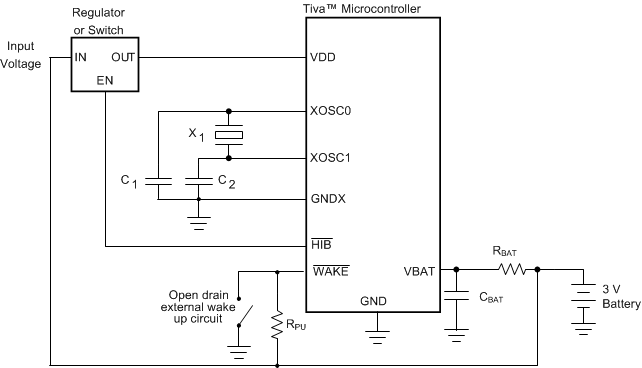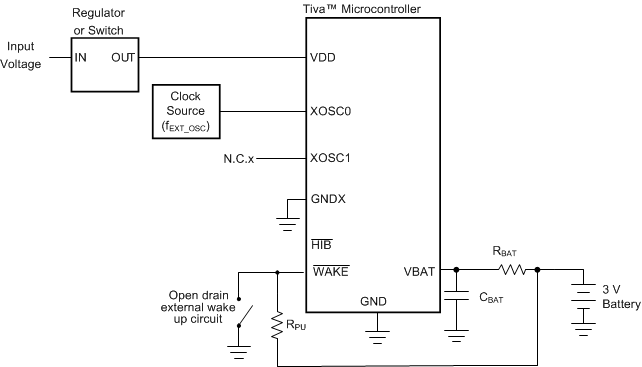SLAU723A October 2017 – October 2018 MSP432E401Y , MSP432E411Y
- 1
- 7
- 65
- 132
-
167
- 168
-
215
- 216
- 217
- 218
- 219
- 220
- 221
- 222
- 223
- 224
- 225
- 226
- 227
- 228
- 229
- 230
- 231
- 232
- 233
- 234
- 235
- 236
- 237
- 238
- 239
- 240
- 241
- 242
- 243
- 244
- 245
- 246
- 247
- 248
- 249
- 250
- 251
- 252
- 253
- 254
- 255
- 256
- 257
- 258
- 259
- 260
- 261
- 262
- 263
- 264
- 265
- 266
- 267
- 268
- 269
- 270
- 271
- 272
- 273
- 274
- 275
- 276
- 277
- 278
- 279
- 280
- 281
- 282
- 283
- 284
- 285
- 286
- 287
- 288
- 289
- 290
- 291
- 292
- 293
- 294
- 295
- 296
- 297
- 298
- 299
- 300
- 301
- 302
- 303
- 304
- 305
- 306
- 307
- 308
- 309
- 310
- 311
- 312
- 313
- 314
- 315
- 316
- 317
- 318
- 319
- 320
- 321
- 322
- 323
- 324
- 325
- 326
- 327
- 328
- 329
- 330
- 331
- 332
- 333
- 334
- 335
- 336
- 337
- 338
- 339
- 340
- 341
- 342
- 343
- 344
- 345
- 346
- 347
- 348
- 349
- 350
- 351
- 352
- 353
- 354
- 355
- 356
- 357
- 358
- 359
- 360
- 361
- 362
- 363
- 364
- 365
- 366
- 367
- 368
- 369
- 370
- 371
- 372
- 373
- 374
- 375
- 376
- 377
- 378
- 379
- 380
- 381
- 382
- 383
- 384
- 385
- 386
- 387
- 388
- 389
- 390
- 391
- 392
- 393
- 394
- 395
- 396
- 397
- 398
- 399
- 400
- 401
- 402
- 403
- 404
- 405
- 406
- 408
- 415
- 482
- 564
- 643
- 715
- 791
- 841
- 855
- 870
-
917
- 918
- 919
- 920
- 1002
- 1017
-
1021
- 1022
- 1023
- 1024
- 1025
- 1026
- 1027
- 1028
- 1029
- 1030
- 1031
- 1032
- 1033
- 1034
- 1035
- 1036
- 1037
- 1038
- 1039
- 1040
- 1041
- 1042
- 1043
- 1044
- 1045
- 1046
- 1047
- 1048
- 1049
- 1050
- 1051
- 1052
- 1053
- 1054
- 1055
- 1056
- 1057
- 1058
- 1059
- 1060
- 1061
- 1062
- 1063
- 1064
- 1065
- 1066
- 1067
- 1068
- 1069
- 1070
- 1071
- 1072
- 1073
- 1074
- 1075
- 1076
- 1077
- 1078
- 1079
- 1080
- 1081
- 1082
- 1083
- 1084
- 1085
- 1086
- 1087
- 1088
- 1089
- 1090
- 1091
- 1092
- 1093
- 1094
- 1095
- 1125
- 1189
- 1251
- 1304
- 1365
- 1431
- 1478
- 1503
- 1552
- 1569
- 1618
-
1669
- 1670
- 1671
- 1672
- 1723
-
1726
- 1727
- 1728
- 1729
- 1730
- 1731
- 1732
- 1733
- 1734
- 1735
- 1736
- 1737
- 1738
- 1739
- 1740
- 1741
- 1742
- 1743
- 1744
- 1745
- 1746
- 1747
- 1748
- 1749
- 1750
- 1751
- 1752
- 1753
- 1754
- 1755
- 1756
- 1757
- 1758
- 1759
- 1760
- 1761
- 1762
- 1763
- 1764
- 1765
- 1766
- 1767
- 1768
- 1769
- 1770
- 1771
- 1772
- 1773
- 1774
- 1775
- 1776
- 1777
- 1778
- 1779
- 1780
- 1781
- 1782
- 1783
- 1784
- 1785
- 1786
- 1787
- 1788
- 1789
- 1790
- 1791
- 1792
- 1793
- 1794
- 1795
- 1796
- 1797
- 1798
- 1799
- 1800
- 1801
- 1802
- 1803
- 1804
- 1805
- 1806
- 1833
6.3.2 Hibernation Clock Source
The HIB module can be clocked by one of three different clock sources:
- A 32.768-kHz oscillator
- An external 32.768-kHz clock source
- An internal low frequency oscillator (HIB LFIOSC)
Table 6-1 summarizes the encodings for the bits in the HIBCTL register that are required for each clock source to be enabled. Note that CLK32EN must be set for any Hibernation clock source to be valid. The Hibernation module is not enabled until the CLK32EN bit is set. The HIB clock source is the source of the RTC Oscillator (RTCOSC), which can be selected as the system clock source by programming a 0x4 in the OSCSRC field of the Run and Sleep Mode Configuration (RSCLKCFG) register in the System Control Module. See Section 4 for more information.
Table 6-1 HIB Clock Source Configurations
| HIB Clock Source | CLK32EN | OSCSEL | OSCBYP |
|---|---|---|---|
| 32.768 kHz oscillator | 1 | 0 | 0 |
| External 32.768-kHz clock source | 1 | 0 | 1 |
| Low-frequency internal oscillator (HIB LFIOSC)(1) | 1 | 1 | 0 |
To use an external crystal, a 32.768-kHz crystal is connected to the XOSC0 and XOSC1 pins. Alternatively, a 32.768-kHz oscillator can be connected to the XOSC0 pin, leaving XOSC1 unconnected. Care must be taken that the voltage amplitude of the 32.768-kHz oscillator is less than VBAT, otherwise, the Hibernation module may draw power from the oscillator and not VBAT during hibernation. See Figure 6-2 and Figure 6-3.
Alternatively, a low frequency oscillator source (HIB LFIOSC) present in the Hibernation module can be a clock source. (The frequency can have wide variations; see the HIB clock specifications in the device-specific data sheet for more details.) The intent of this source is to provide an internal low-power clock source to enable the use of the asynchronous pin wakes and memory storage without the requirement of an external crystal. To enable the HIB LFIOSC to be the clock source for the Hibernation module, both the OSCSEL bit and the CLK32EN bit in the Hibernation Control (HIBCTL) register must be set.
NOTE
The HIB low-frequency oscillator (HIB LFIOSC) has a wide frequency variation, therefore the RTC is not accurate when using this clock source. It is not recommended to use the HIB LFIOSC as an RTC clock source.
The Hibernation module is enabled by setting the CLK32EN bit of the HIBCTL register. The CLK32EN bit must be set before accessing any other Hibernation module register. The type of clock source used for the HIB module is selected by setting the OSCSEL and OSCBYP bit of the HIBCTL register. If the internal low frequency precision oscillator is used as the clock source, the OSCSEL bit should be set to a 1 at the same time the CLK32EN bit is set. If a crystal is used for the clock source, the software must leave a delay of tHIBOSC_STARTafter writing to the CLK32EN bit and before any other accesses to the Hibernation module registers. The delay allows the crystal to power up and stabilize. If an external oscillator is used for the clock source, no delay is needed. When using an external clock source, the OSCBYP bit in the HIBCTL register should be set. When using a crystal clock source, the GNDX pin should be connected to digital ground along with the crystal load capacitors, as shown in Figure 6-2. When using an external clock source, the GNDX pin should be connected to digital ground.
NOTE
In the following figures, the parameters RBATand CBAThave recommended values of 51Ω ±5% and 0.1µF ±5%, respectively. See the HIB electrical specifications in the device-specific data sheet for more information.
 Figure 6-2 Using a Crystal as the Hibernation Clock Source with a Single Battery Source
Figure 6-2 Using a Crystal as the Hibernation Clock Source with a Single Battery Source NOTE
Some devices may not supply the GNDX signal. If GNDX is absent, the crystal load capacitors can be tied to GND externally. See for pins specific to your device.
X1 = Crystal frequency is fXOSC_XTAL.
C1,2 = Capacitor value derived from crystal vendor load capacitance specifications.
RPU = Pullup resistor is 200 kΩ
RBAT = 51 Ω ±5%
CBAT = 0.1 µF ±20%
See the HIB electrical specifications in the device-specific data sheet for specific parameter values.
 Figure 6-3 Using a Dedicated Oscillator as the Hibernation Clock Source with VDD3ON Mode
Figure 6-3 Using a Dedicated Oscillator as the Hibernation Clock Source with VDD3ON Mode NOTE
Some devices may not supply a GNDX signal. See for pins specific to your device.
RPU = Pullup resistor is 1 MΩ
RBAT = 51 Ω ±5%
CBAT = 0.1 µF ±20%